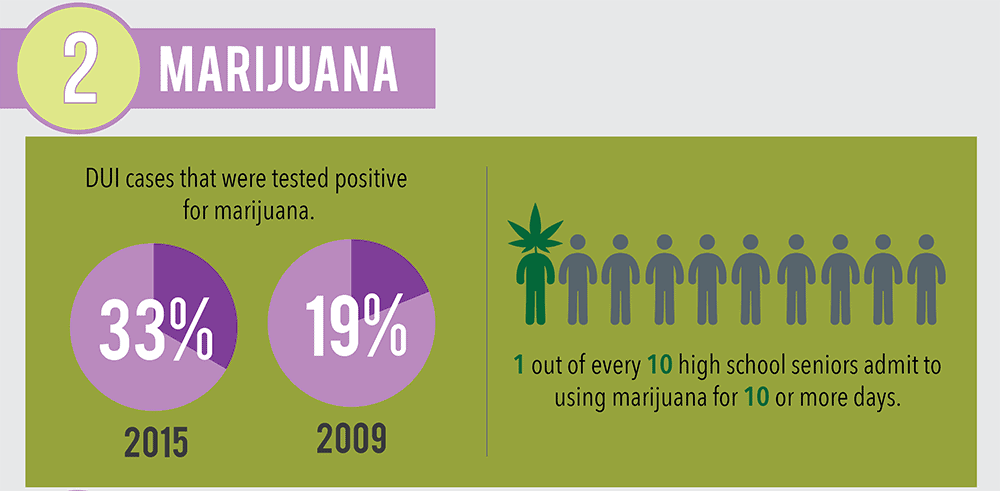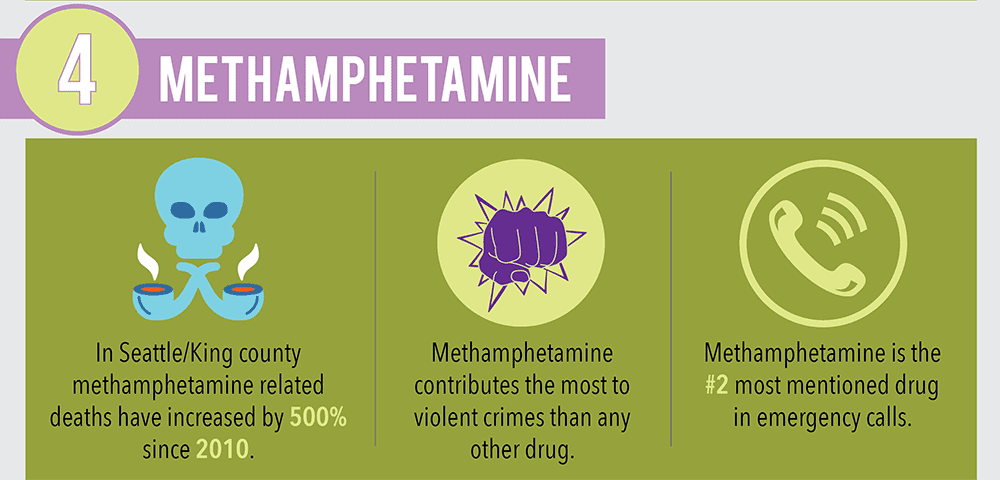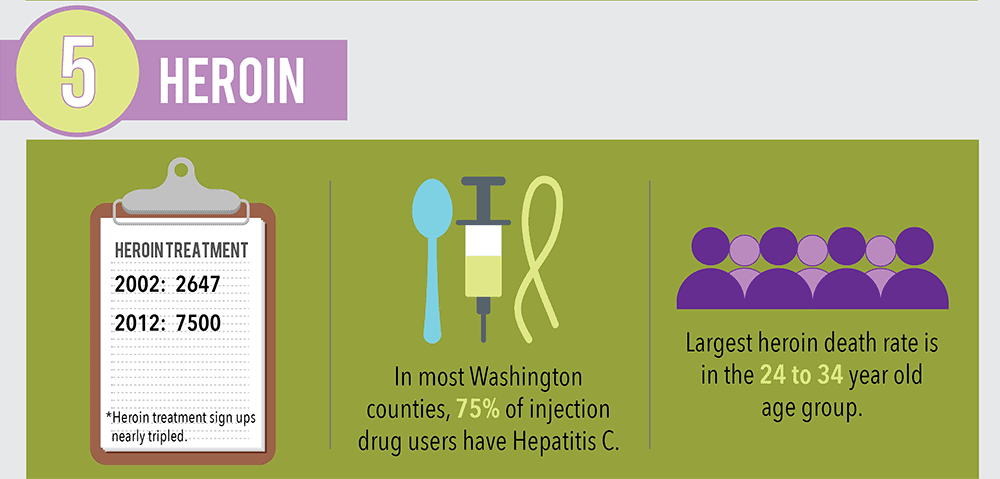“Across our state, we are seeing the terrible effects of heroin and prescription narcotics on our families, friends and communities. Although more must be done, we’ve made significant progress in reducing overprescribing of opioids, and with health care reform, a record number of families who just a few years ago had no medical coverage and limited means to regain their health, can now seek treatment for substance use disorders.” ~ Washington State Governor Jay Inslee Washington State has more than its fair share of substance abuse concerns. Illicit drug use, alcohol abuse, and especially, prescription opioid medication misuse is all higher in Washington than the US average. From all reports, there are a few frightening statistics about substance abuse in Washington State that stand out more than any other:
- 13% of all deaths in Washington State are related to drugs or alcohol.
- More than half of all people in treatment for substance abuse in Washington State are there for both alcohol and drugs.
- Illicit drug use among adolescents is considerably higher than the national average, 11.5% versus 9.2% in 2012-2013.
- 23% of people in Washington who have a severe mental illness also have a comorbid substance abuse disorder – much higher than the US median of 18.5%.
- 9 out of 10 people with a substance abuse disorder in the state have not gotten treatment within the past year.
Let’s take a closer look at some of the most-commonly-abused drugs in the State of Washington: 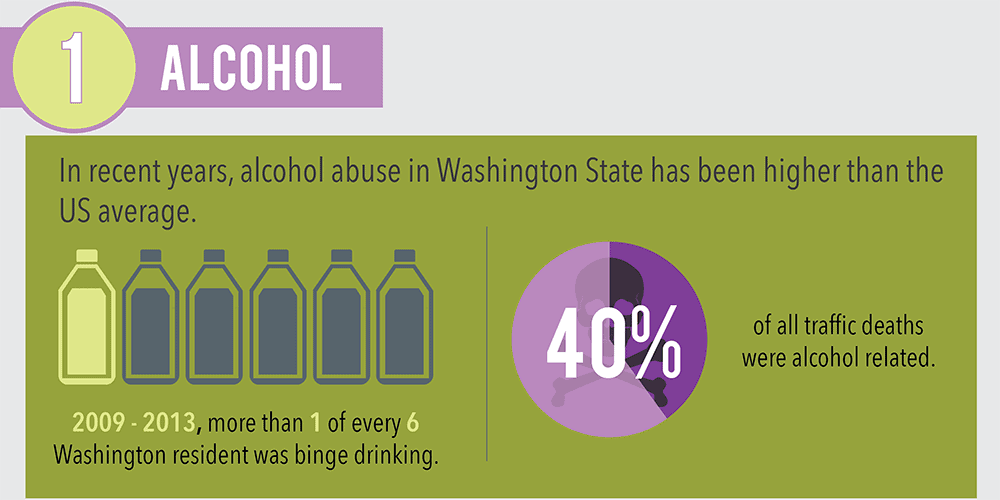
Washington State’s #1 Most-Abused Drug – Alcohol
“It needs to be recognized that by far, the biggest drug problem in the state is alcohol.” ~ David Albert, the Division of Alcohol and Substance Abuse Alcohol is the most-abused drug on Earth, and Washington State is no exception:
- For the past few years, alcohol abuse among Washington residents has regularly been higher than the US average.
- In 2013, 7.6% of Washington residents age 12 or older abused or were dependent upon alcohol within the past year, compared with 6.7% for America as a whole.
- 2009-2013, more than 1 in every 6 Washingtonians engaged in binge-drinking within the past month.
- 40% of all traffic deaths in Washington State are alcohol-related.
- Nearly 1 out of every 4 Washington State high-school seniors report a problem with alcohol use.
Washington State’s #2 Most-Abused Drug – Marijuana
“The new analysis complements previous population-level studies… that shows that marijuana use can lead to harmful consequences for individuals and society.” ~ Dr. George Koob, Ph.D., Director of the National Institute on Alcohol Abuse and Alcoholism Since its legalization in 2012, marijuana’s popularity in the State of Washington has only increased.
- In 2013-2014, just under 19% of all Washington State residents age 12 or older reported past-year use of marijuana.
- That is up from over 15% in 2011-2012.
- The number climbs higher as the age group gets older –over 31% of Washington adults 18-25 report past-month use of marijuana
- Almost 33% of DUI cases in Washington in 2015 tested positive for marijuana
- In 2009, that number was only around 18%.
- 27% of Washington State high-school seniors have used marijuana within the past month up from 19% a decade ago.
- 1 out of every 10 high school students in the state used marijuana 10 days or more within the past month.
- 45% of publicly-funded treatment admissions where marijuana was the drug of choice were for people under the age of 18.
- THC levels in marijuana have reached 13%. In 1975, that potency was only at 1%.
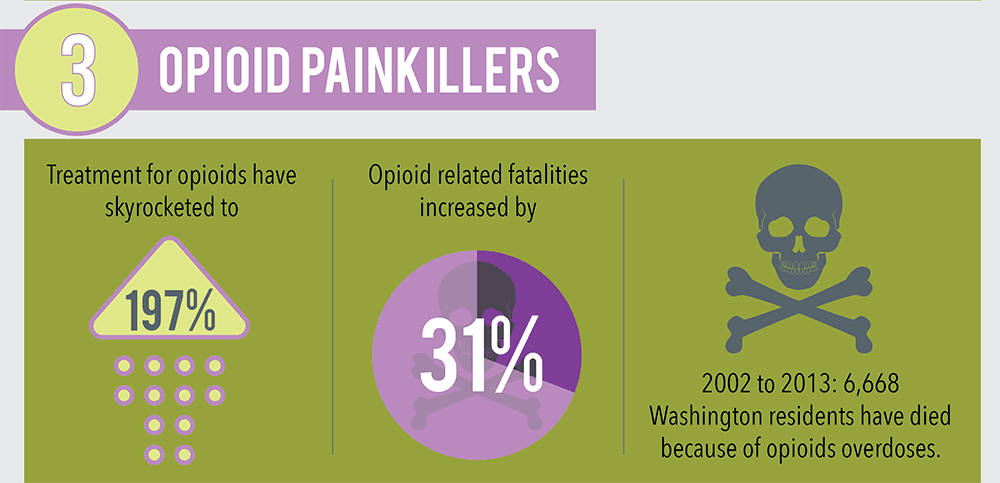
Washington State’s #3 Most-Abused Drug – Opioid Painkillers
“The link between heroin and the abuse of prescription narcotics is one more reason to prevent overprescribing. These are powerful drugs that should be prescribed cautiously, using the lowest dose for the shortest amount of time necessary.” ~ Dr. Gary Franklin, Medical Director at the Washington State Department of Labor and Industries Comparing two different time periods a decade apart, 2002-2004 and 20011-2013, it is easy to recognize the opioid trend in Washington State:
- Treatment admissions for opioids shot up 197%.
- Out of 39 Washington State counties, 38 experienced an increase in opioid admissions
- Opioid-related fatalities increased by 31%
- Between 2002 and 2013, 6668 Washington State residents died because of opioid overdoses.
Washington State’s #4 Most-Abused Drug – Methamphetamine
“I think meth is still the drug that’s most well-entrenched.” ~ Dave Rodriguez, Director of the Northwest High-Intensity Drug Trafficking Area (HIDTA) According to HIDTA reports, meth is the “most prevalent” drug in the state and, along with heroin, Washington State’s “greatest drug threat“:
- In the largest city and county in Washington State – the Seattle/King County region – deaths involving methamphetamine have increased by 500% since 2010.
- Deaths from prescription drugs are highest in the 45-to-54-year-old age group.
- In 2014 – for the first time –meth became the most-commonly-detected drug in police evidence testing.
- Methamphetamines are the #2 most-mentioned drug in emergency calls to the Help Line.
- 1 out of every 4 heroin abusers also use methamphetamine, in a combination called “goofballs”.
- Out of all possible drugs of abuse, methamphetamine contributes the most to violent crime in Washington State.
Washington State’s #5 Most-Abused Drug – Heroin
“In the state of Washington, heroin is the number one drug threat.” ~ Jodie Underwood, Spokesperson for the Drug Enforcement Agency NW HIDTA has reported that heroin and methamphetamines are the greatest drug threats in Washington State:
- In 2014, 293 Washingtonians died because of a heroin overdose – double 2008’s total.
- That same year, King County suffered the most deaths involving heroin in more than two decades.
- In 2009, there were 49 heroin-related deaths in King County, but by 2012 that number had increased to 84.
- 2010-2014, heroin admissions in King County doubled, and are at the highest point of any drug since 1999.
- 2004-2014, the largest increase in fatal heroin overdoses occurred in the 15-34-year-old demographic.
- Overall, the largest heroin death rate is among 25-34-year-old age group.
- 2002-2012, heroin treatment admissions nearly tripled, 2647 to 7500.
- In some counties in Washington State, up to 75% of intravenous drug users have Hepatitis C.
- 80% of heroin abusers were first addicted to prescription opioids.
- Over 90% of individuals who switch from opioid painkillers to heroin say that they did so because heroin is “cheaper and easier to obtain“.
What Do All of These Washington State Drug Statistics Mean?
By any measure, drug addiction and alcohol abuse in Washington State is a worsening problem that affects hundreds of thousands of state residents. It means that now, more than ever, there is an urgent need for timely intervention and effective, evidence-based treatment that is focused on the total wellness of the suffering substance abuser.
Full Infographic:
 2014 Washington State Healthy Youth Report 2014 Washington Behavioral Health Barometer, prepared for the Substance Abuse and Mental Health Services Administration Opioid Trends across Washington State (April 2015), prepared by the University Of Washington Alcohol and Drug Abuse Institute Drug Abuse Trends in the Seattle-King County Area: 2014, prepared by the University Of Washington Alcohol and Drug Abuse Institute https://www.kitsapsun.com/news/code-911/stats-show-meth-use-still-strong-in-county-as-heroin-takes-hold-ep-509830267-355543751.html?d=mobile https://www.npr.org/2015/08/19/432896393/more-washington-drivers-use-and-drive https://m.seattlepi.com/local/article/Drug-and-alcohol-use-rises-in-Washington-state-1295854.php https://www.washington.edu/news/2015/12/29/no-easy-answers-in-uw-study-of-legal-marijuanas-impact-on-alcohol-use/ https://www.kingcounty.gov/elected/executive/constantine/News/release/2016/March/01-heroin-task-force.aspx https://www.seattletimes.com/seattle-news/marijuana/violent-car-crashes-tied-to-rapidly-changing-drug-spice-alarm-police-health-experts/ https://www.doh.wa.gov/Newsroom/2015NewsReleases/15188OpioidOverdoseDeathsNewsRelease https://www.oregonlive.com/pacific-northwest-news/index.ssf/2013/06/washington_heroin_use_deaths_i.html https://lib.adai.washington.edu/dbtw-wpd/exec/dbtwpub.dll?BU=http%3A//lib.adai.washington.edu/researchsearch.htm&QF0=Status&QI0=Current&TN=Research&RL=0&DF=Full&RF=Current&AC=QBE_QUERY&CS=0&MF=searchbutton.ini https://www.spokesman.com/stories/2016/feb/21/as-state-deals-with-heroin-epidemic-an-anguished-f/ https://mail.google.com/mail/u/0/?tab=wm#inbox/1533778251b4f165 https://adai.uw.edu/wastate/wastate.htm https://www.niaaa.nih.gov/alcohol-health/overview-alcohol-consumption/alcohol-facts-and-statistics https://hsnewsbeat.uw.edu/sites/default/files/sites/default/files/documents/King%20County%20Drug%20Trends%20Report%202015.pdf https://www.countyhealthrankings.org/app/washington/2015/rankings/king/county/outcomes/overall/snapshot https://www.drugfree.org/news-service/heroin-use-on-the-rise-in-washington-state-report-finds/ https://adai.uw.edu/pubs/InfoBriefs/ADAI-IB-2013-02.pdf
2014 Washington State Healthy Youth Report 2014 Washington Behavioral Health Barometer, prepared for the Substance Abuse and Mental Health Services Administration Opioid Trends across Washington State (April 2015), prepared by the University Of Washington Alcohol and Drug Abuse Institute Drug Abuse Trends in the Seattle-King County Area: 2014, prepared by the University Of Washington Alcohol and Drug Abuse Institute https://www.kitsapsun.com/news/code-911/stats-show-meth-use-still-strong-in-county-as-heroin-takes-hold-ep-509830267-355543751.html?d=mobile https://www.npr.org/2015/08/19/432896393/more-washington-drivers-use-and-drive https://m.seattlepi.com/local/article/Drug-and-alcohol-use-rises-in-Washington-state-1295854.php https://www.washington.edu/news/2015/12/29/no-easy-answers-in-uw-study-of-legal-marijuanas-impact-on-alcohol-use/ https://www.kingcounty.gov/elected/executive/constantine/News/release/2016/March/01-heroin-task-force.aspx https://www.seattletimes.com/seattle-news/marijuana/violent-car-crashes-tied-to-rapidly-changing-drug-spice-alarm-police-health-experts/ https://www.doh.wa.gov/Newsroom/2015NewsReleases/15188OpioidOverdoseDeathsNewsRelease https://www.oregonlive.com/pacific-northwest-news/index.ssf/2013/06/washington_heroin_use_deaths_i.html https://lib.adai.washington.edu/dbtw-wpd/exec/dbtwpub.dll?BU=http%3A//lib.adai.washington.edu/researchsearch.htm&QF0=Status&QI0=Current&TN=Research&RL=0&DF=Full&RF=Current&AC=QBE_QUERY&CS=0&MF=searchbutton.ini https://www.spokesman.com/stories/2016/feb/21/as-state-deals-with-heroin-epidemic-an-anguished-f/ https://mail.google.com/mail/u/0/?tab=wm#inbox/1533778251b4f165 https://adai.uw.edu/wastate/wastate.htm https://www.niaaa.nih.gov/alcohol-health/overview-alcohol-consumption/alcohol-facts-and-statistics https://hsnewsbeat.uw.edu/sites/default/files/sites/default/files/documents/King%20County%20Drug%20Trends%20Report%202015.pdf https://www.countyhealthrankings.org/app/washington/2015/rankings/king/county/outcomes/overall/snapshot https://www.drugfree.org/news-service/heroin-use-on-the-rise-in-washington-state-report-finds/ https://adai.uw.edu/pubs/InfoBriefs/ADAI-IB-2013-02.pdf

